TSOTA meets Antonia Lovelace Curator of World Cultures at Leeds City Museum
February 5, 2015

Voices of Asia is a vibrant gallery at Leeds City Museum which celebrates the sights, sounds, and culture of Asia and the Asian communities living in the multicultural city of Leeds. The displays, planned in partnership with local Asian community groups and a local Advisory Network, will stay in the space for around five years, but will change each year to explore different projects, themes and world faiths. The items exhibited reflect the large number of Leeds people travelling and working in Asia from the late 18th century onwards.
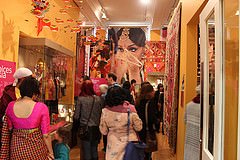
Image courtesy of Leeds Museums and Galleries
TSOTA caught up with Curator of World Cultures Antonia Lovelace in the ‘Voices of Asia’ gallery in Leeds City Museum to hear about her favourite objects on show, stylistic choices for the gallery and what sparked her interest in Asian culture…
TSOTA: What is the story behind the Voices of Asia gallery?
AL: The idea for this gallery developed from the success of the Chinese Treasures exhibition(s) in Leeds as part of China in Yorkshire in 2008. In 2009 I worked with my colleague Gabrielle Hamilton on ‘Faith in the City’ which was a community display and events programme in the Leeds gallery at Leeds City Museum. She made several films that celebrated the different world faiths in Leeds, with the film-maker Mojo Media. Thanks to this project we strengthened our links with different communities within the city. I realised we had over 2,000 Chinese objects in the museum collections, and more than 6000 from Asia overall, a huge pot of items to choose from. In a gallery space like this there’s around 220 objects on show – you may think there’s a lot more but you have to be selective about what you include on display, and you need time and space to make the selection.
It was a personal push from my part that I wanted the opportunity and funding for the first change-over at Leeds City Museum to be in the World View space. We had the Africa display before but it was quite muted in terms of colour-all cream and beige and some red. We recruited an advisory panel from the university and from different community networks and then a designer (Peter Farmer) who really pushed us to go for much more colour for Voices of Asia. We worked with photographer Sara Porter- she did the Natural Beauty wildlife photography exhibition for us in 2013 – so we knew that we already had a really good photographer on board. A series of meetings over a year and a half brought the whole thing together.
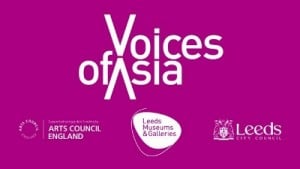
Vimeo.com
TSOTA: Can you tell me more about the funding for the Voices of Asia gallery?
AL: We are lucky in Leeds that we receive Major Partner Museum funding from the Arts Council England, an award that brings in an extra 1.3 million a year. It was a 3 year award from 2012 and now they have given one more year. It funds a lot of audience development work but also display changes, as was the case here. In recent years this Arts Council funding has paid to have a community curator in every venue which has been really helpful. That whole side of things has come on a lot. In the past few years we have also been really keen to build our internship and placements programme. Some of these are really critical to the development of the exhibitions. I had a Taiwanese intern the year before last who made her own films about Bubble-Tea, Sushi and fried fish, together with her Japanese boyfriend.
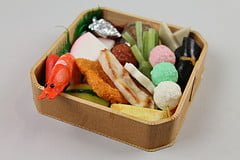
Image courtesy of Leeds Museums and Galleries
TSOTA: What does your role as curator of world cultures involve? I imagine it can be quite varied?
AL: Yes it can vary quite a lot. There are always a lot of emails to answer both internal and external. My work is split between exhibition work and looking after the collections but for me it is really important to get out and see everything too. Part of my work is to keep an eye on what’s going on within these local communities and to try go to events as well. I have lived in Leeds for 17 years so have had time to learn things and build relations. The person who runs our team of community curators has lived in Leeds most of her life, and this makes a big difference.
TSOTA: What kind of events have you been along to?
We’ve been along to Diawli at the Hindu temple twice. There have been particular open days at the mosques where they have asked for us to come along and do a display-we have tried to maintain links with these groups beyond Faith in the City (2009). I also go along as a learner to events such as ‘find out about Islam day’. It’s very important to keep going along to things. Last week after the terrorist attacks in Paris we went along to meet a group of mixed faith women who were doing an embroidery project at the Hamara Centre in Beeston and it was so nice to share this creative project with them and to focus on moving forward.
TSOTA: Images and film seem to be an important part of the aesthetics of the exhibition- can you tell me more about this?
AL: Film is as important as the big photos. It’s really important that you don’t have a quiet gallery –this way it’s quiet until someone presses a button. It can be a real pain for the visitor assistants to hear too much noise all the time-we need something that’s half and half. Film and photography are as important as the objects to bring flavour to the gallery. Even though we have historic collections people want to see contemporary objects too that they can relate to from their daily life.
TSOTA: Are you going to change the short films that are featured in the gallery?
AL: It’s a question of finance really. It costs around £2,000 per film because of the editing costs to bring the footage down to 4/5 minutes. We are definitely going to do something with one of the Leeds mosques that is moving to new premises this year. I really want to catch the first service at the new mosque on film.
TSOTA: Are there any particular favourite objects of yours amongst the Voice of Asia collection?
AL: Yes, I have picked four of my favourite objects from the collection to talk you through.
1. Budda, Gandhara Culture, India, 100-300 AD
One of the oldest objects is this beautiful stone statue of Buddha from 100-300 AD which we have from Lotherton Hall. It has Greek influences and is an ancient and very beautiful sculptural form. If you walk around Leeds it just so happens that the statues that you will most commonly come across are Buddhist. For some reason they are thought of as internationally benign or neutral enough. A lot of the newer Thai restaurants have lovely Buddhist statues. Often supermarkets such as M&S sell them too. One of the hairdressers in Headingley that I pass on the bus down Otley road even has ‘Buddha Wednesdays.’ We always try to really make the most of the best pieces we have but to link them to something that you might have seen whilst wandering around Leeds.
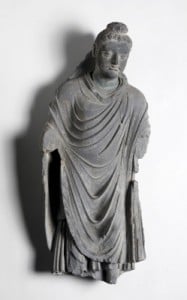
Image courtesy of Leeds Museums and Galleries
2. Jali Screen, Rajasthan, India, c.1900
We have this Jali screen from a collector who used to work as a curator in the Leeds Art Gallery back in the 80s, Terry Friedman. He loved Indian and Islamic pattern and found this on sale somewhere in the UK. The screenwork is meant to help let air and light in whilst also keeping the temperature down. This was a bequest that arrived literally 3 months before the gallery opened. You used to see this type of screen in older restaurants when I came to Leeds back in the 90s- the more traditionally designed restaurants would have these types of screen with the open wood panelling. Nowadays the restaurants seem to be more minimalist (with the exception of places like the Ancient Egyptian flavoured décor of Akbars on Eastgate).
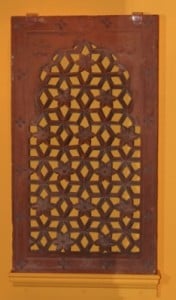
Image courtesy of Leeds Museums and Galleries
3. Krishna & Radha, Rajasthan and Gujarat, India, 2002
We had a bit of a coup because we borrowed the large marble Krishna from the Hindu temple for Faith in the City in 2009 and then when we went to return it they asked us if we would like to buy Krishna with his consort Radha. The statues were originally brought over in 2002 for a big refurbishment of the altar shrines. However, when they arrived the congregation decided the statues weren’t big enough so they were going spare. We were lucky to get them directly from Leeds Hindu temple; it was much cheaper than importing them from India as you can imagine and we got grant aid to purchase them.
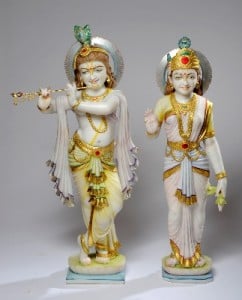
Image courtesy of Leeds Museums and Galleries
4. Lion Mask China 2007-2008 (child sized)
I am also really fond of this Chinese New Year mask. You get them in the shape of lions, dragons and unicorns. They are worn for a dance and made for two people-the front dancer is like the pantomime cow or donkey in our culture. For me this embodies the fun of Chinese art-you can combine pink and red and then orange and yellow, scruffy balls and eyes. It’s one of my favourites.
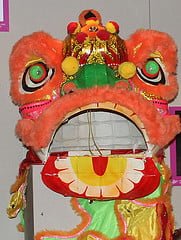
Image courtesy of Leeds Museums and Galleries
TSOTA: What has the reception been like generally from members of the public towards the gallery?
AL: We don’t have any detailed evaluation yet but the feedback from the visitor assistants has been really positive. People like the change of perspective when you come in here in terms of the colour and the big photos. It’s great for members of the different Asian communities to come and see objects from their own culture on display but it can be a bit competitive too at times.
TSOTA: What new additions to the collection can we expect to see in the future? Which artists are you planning on working with in the future?
AL: We will change everything probably in June this year. I am not looking forward to taking the kites down-I really like them. Because of the lighting you shouldn’t keep paper or textile items up for more than a year or so. We are always looking to acquire new objects-at the moment we are looking for those related to political events as well as new toys and games. We also need more beautiful examples of traditional work that we may not have already. We have asked our Korean intern May about what type of Korean items might be interesting to include in the future. We prefer not to buy on the web, but to wait until we find the right items through a personal contact. We have also tried hard to borrow around 10% of what is on show, we don’t have to purchase everything.
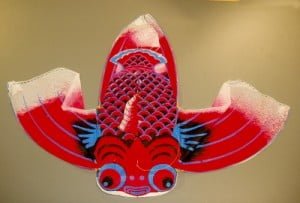
Image courtesy of Leeds Museums and Galleries
We will change to Islam this summer, and then we are thinking of doing Sikhism in 2016, Christianity in 2017, and Buddhism in 2018, then Judaism as well at some point afterwards.
There is a local graphic artist who does beautiful calligraphy and we are hoping to show his work when we move over to Islam. A lot of the art on display was lent to the museum as a personal favour as we can’t afford the thousands of pounds to import them. From amongst the many art collectors/patrons in Leeds there are quite substantial Asian collections out there that we can borrow from or younger artists whose work we can display.
For more information visit the Leeds City Museum website
If you would like to share a story or get involved in the changing programme of the gallery contact Curator of World Cultures, Antonia Lovelace at [email protected]
Or join the conversation on Twitter and Facebook #VoicesofAsia #VoA
Filed under: Art & Photography
Tagged with: curator, interview, leedscitymuseum, voicesofasia, worldcultures
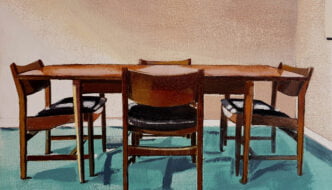
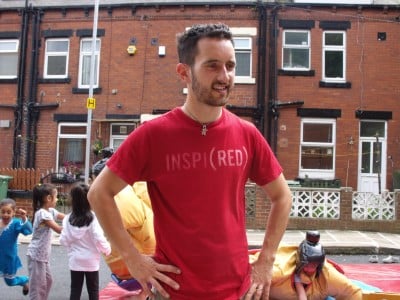
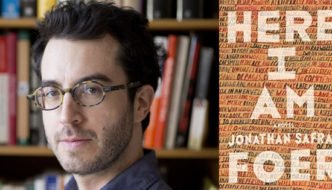
Comments